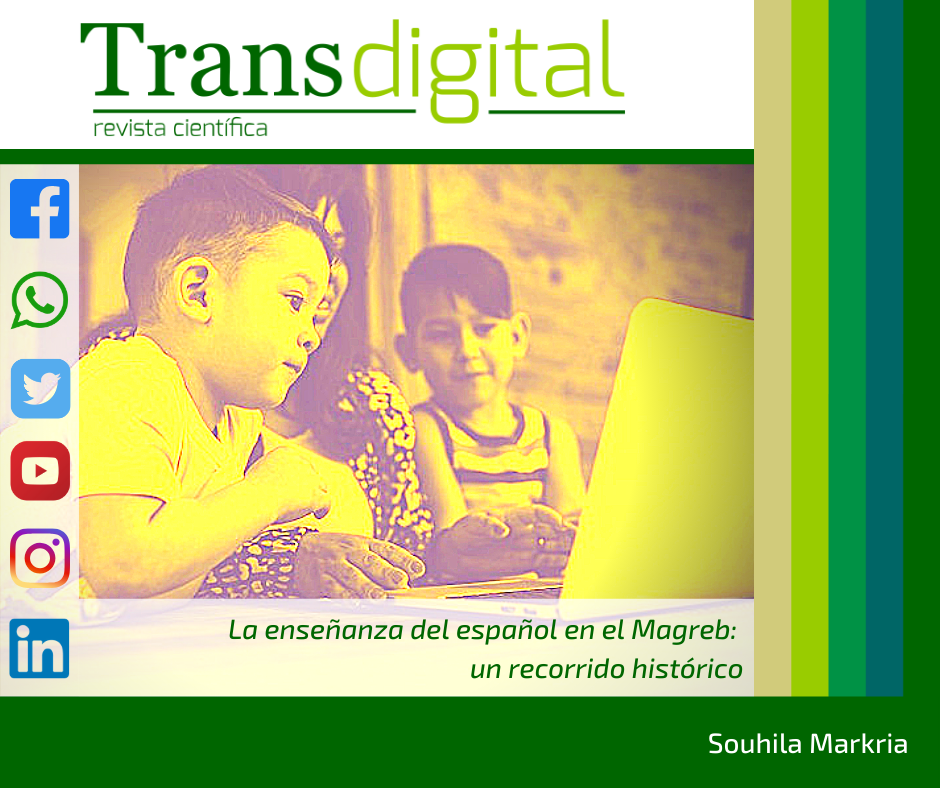The Spanish teaching in the Maghreb: a historical review
DOI:
https://doi.org/10.56162/transdigital23Keywords:
teaching, spanish, Maghreb, historical review.Abstract
The presence of the Spanish language in the Muslim world is essential for an accessible dialogue between civilizations as well as for reaching a reciprocal interest. Spanish as a foreign language is studied in the Maghreb after an advanced training of standard Arabic and French, in school teaching, and after English in secondary education. This text carries out a review of the history of the teaching of Spanish in the Maghreb, since it was introduced by the descendants of the Jews expelled from the Iberian Peninsula, at the end of the Middle Ages, until the Spanish conquest of the Maghreb. The particular objective is to summarize a general approach to the teaching of Spanish as a foreign language in the Maghreb, both in secondary and higher education. Thus, it is expected to identify the main classical or digital methods used to achieve an advanced level in Spanish. The above, because we are currently notoriously influenced by information and communication technologies and globalization. As the Maghreb maintains a bilateral relationship with Spain, the workforce in the Maghreb requires new skills for new jobs, whether pedagogical or practical, such as the world of business, tourism, etc. Precisely, the teaching of Spanish as a foreign language should focus on the attitudes, values, basic knowledge that university students would request because this acquired competence plays a very important role in keeping this relationship between the two worlds: the Maghreb and the Hispanic world.
References
Anónimo. Colegio Sediki primer colegio tunecino. Obtenido el 20-10-2019 en: https://www.tekiano.com/2015/08/11/rentree-scolaire-les-plus-anciens-colleges-de-tunisie/
Arroyo, F. (viernes, 20 de marzo de 1992). El español segunda lengua en el bachillerato argelino, El País. Obtenido en: https://elpais.com/diario/1992/03/20/sociedad/701046009_850215.html
Benyaya, Z. (2007). La enseñanza del español en Marruecos: del pasado al presente, Porta Linguarum, enero (7), pp.167-180. Obtenido en: http://hdl.handle.net/10481/31607
Burke, P. (2005). History and Social Theory. Cambridge: Polity Press.
Cassany, D. (2010). Prácticas letradas contemporáneas. Ministerio de Educación. Gobierno de España. Obtenido en: https://repositori.upf.edu/bitstream/handle/10230/21294/Cassany_LEERES.pdf
Ciarra, A. (2011). El correo electrónico como recurso en ELE; análisis del discurso y propuesta didáctica para el nivel intermedio (B1-B2), Actas del Congreso XXI Congreso Internacional de la ASELE, Salamanca, pp. 289-290.
De Agreda, F. (2008), Centros de Arabia y los centros marroquíes, Hesperia, culturas del Mediterráneo, VI (III), pp. 201-210.
de Epalza Ferrer, M. (2010). El español hablado en Túnez por los moriscos o andalusíes y sus descendientes (siglos XVII-XVIII), Valencia: Universidad de Valencia.
Fernández, D. (2014). La pervivencia del español en el Magreb, Centro Virtual Cervantes. Obtenido en: https://cvc.cervantes.es/lengua/iecibe/03_fernandez.htm
Goetz, R. H. (2007). La lengua española: panorama sociohistórico. Jefferson, N.C.: McFarland & Co.
Herrera, F. (2012). Aprendizaje en red y actividades digitales significativas, Mosaico, 28, pp.4-7.
Instituto Cervantes (2018). El Instituto Cervantes presenta hoy el anuario: El español en el mundo 2017. Obtenido en: https://www.cervantes.es/sobre_instituto_cervantes/prensa/2017/noticias/Presentaci%C3%B3n-Anuario-2017.htm
Landry, R., Becheikh, N., Amara, N., Ziam, S., Idrissi, O., & Castonguay, Y. (2008). Revue systématiques des écrits sur le transfert de connaissances en éducation. Québec, Canada: Gouvernement de Québec, Ministère de L’éducation, du Loisir et du Sport.
Markria, S. (2013). La situación del español en las tres zonas magrebíes (Túnez; Marruecos y Argelia), Centro de Cervantes, pp. 84-89. Obtenido en: https://cvc.cervantes.es/ensenanza/biblioteca_ele/publicaciones_centros/PDF/oran_2013/13_markria.pdf
Martinell, E. & Cruz, M. (2006). Cuestiones del español como lengua extranjera, Barcelona: Universidad de Barcelona.
Martínez, C. (2015). El español en Marruecos: su influencia en el desarrollo sociocultural del país, Madrid: Universidad Pontificia Comillas. Obtenido en: https://repositorio.comillas.edu/rest/bitstreams/16196/retrieve
Ministerio de Educación y Formación Profesional. (2018). El mundo español estudia español: Túnez. Madrid: Gobierno de España. Obtenido en: https://www.educacionyfp.gob.es/marruecos/dam/jcr:55b8f81a-2de2-4136-a9e3-c646a034d337/emee-2018-tunez-es.pdf
Morales, J. (2014). Perspectivas tecnológicas en la didáctica de la lengua. En Mª P. Núñez y J. Rienda Polo, Aproximación didáctica a la lengua y la literatura. Madrid: Síntesis.
Peregil, F. (16 enero 2018). El español pierde peso en la enseñanza en Marruecos, El país, Rabat. Obtenido en: https://elpais.com/cultura/2018/01/14/actualidad/1515916638_630810.html
Varo, D. & Cuadros, R. (2013). Twitter y la enseñanza del español como segunda lengua, RedELE, 25, pp.93-115.

Downloads
Autor de correspondencia
El autor de correspodencia se identifica con el siguiente símbolo: *Published
How to Cite
License
Copyright (c) 2020 Souhila Markria

This work is licensed under a Creative Commons Attribution 4.0 International License.
All articles in Transdigital are licensed under a Creative Commons Attribution 4.0 International License. Authors hold the copyright and retain publishing rights without restrictions.









